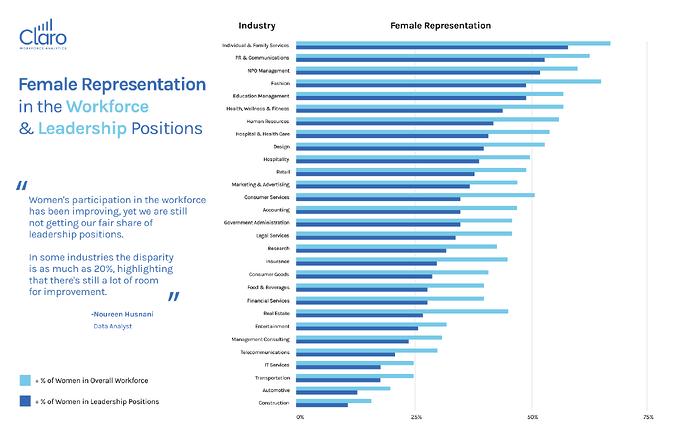Women’s representation in the workforce has increased over time, but women still lack representation in positions of leadership. To explore this inequality between women in the workforce and the percentage of women in leadership positions, we took a closer look into the gap. On our journey, we collected data on many industries, and in some, the disparity is as great as 20% between non-leadership positions and leadership positions. Why does this gap exist?

Despite the fact that more women have advanced degrees than men, women still occupy significantly less leadership positions in their respective industries. For instance, “more than 50% of graduates of four-year colleges are women. Fifty percent of law school graduates are women, and women now constitute more than 40% of those graduating from the top 10 business schools” (Posner, 2019), but females represent only 20% of equity partner positions, and “Women are only 7 percent of top executives in the Fortune 100 companies” (Warner, Ellmann, Boesch, 2018). Furthermore, the overall leadership gap barely budged in the past decade, so there has been severe inaction on this issue.
This lack of growth toward equal leadership representation might be caused by lingering gender stereotypes and stigmas against women holding positions of power. Even in industries like Family Services and PR, where women make up the majority of the workforce, they still lack equivalent leadership representation. Are these women being unfairly denied leadership positions, or do many women feel suppressed by the current male-dominated leadership enough to disincentivize them from applying?
Regardless of the precise cause of the problem, it is clear that much work needs to be done to remedy the disparity between women in the workforce and women who hold leadership positions in their industries. Anyone can help promote equality and inclusivity; you can start with an act as small as encouraging the women you interact with to apply for positions of power. Being thoughtful and actively eliminating bias can help make the workforce feel safer and more empowering for all, for women offer unique perspectives that will better their industries and communities if given a platform.
I believe that as more women gain representation in positions of leadership, it will inspire even more women to pursue those positions. The change starts with encouraging and providing leadership opportunities to women equal to men. Once that is accomplished, the gap will begin to narrow, as women will gain more leadership representation and other women will be inspired by the possibility of their own success.
Sources:
https://www.americanprogress.org/issues/women/reports/2018/11/20/461273/womens-leadership -gap-2/
https://www.pewsocialtrends.org/fact-sheet/the-data-on-women-leaders
